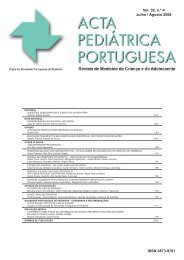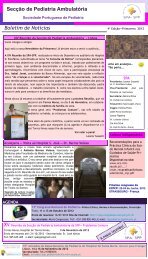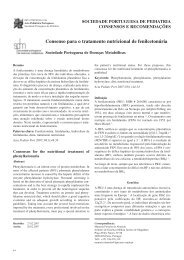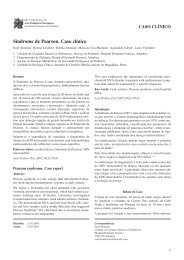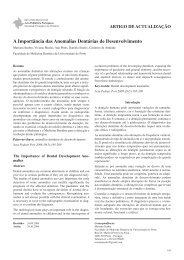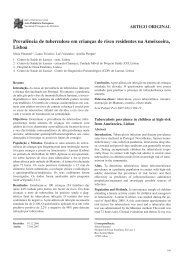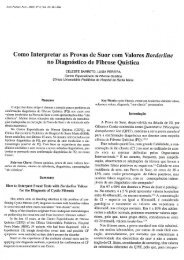Acta Ped Vol 42 N 3 - Sociedade Portuguesa de Pediatria
Acta Ped Vol 42 N 3 - Sociedade Portuguesa de Pediatria
Acta Ped Vol 42 N 3 - Sociedade Portuguesa de Pediatria
You also want an ePaper? Increase the reach of your titles
YUMPU automatically turns print PDFs into web optimized ePapers that Google loves.
0873-9781/11/<strong>42</strong>-3/99<br />
<strong>Acta</strong> <strong>Ped</strong>iátrica <strong>Portuguesa</strong><br />
<strong>Socieda<strong>de</strong></strong> <strong>Portuguesa</strong> <strong>de</strong> <strong>Ped</strong>iatria<br />
ARTIGO ORIGINAL<br />
Deficiência <strong>de</strong> alfa-1 antitripsina num grupo <strong>de</strong> crianças com patologia<br />
respiratória: experiência da consulta <strong>de</strong> <strong>Ped</strong>iatria/Alergologia do hospital<br />
<strong>de</strong> Vila Real<br />
JC Fernan<strong>de</strong>s Fraga, Aida Sá, Vânia Martins, Juan Calvino, António Pereira, Márcia Quaresma<br />
Serviço <strong>de</strong> <strong>Ped</strong>iatria do Centro Hospitalar <strong>de</strong> Trás-os-Montes e Alto Douro, EPE; Unida<strong>de</strong> <strong>de</strong> Vila Real<br />
Resumo<br />
Introdução: A <strong>de</strong>ficiência <strong>de</strong> alfa-1 antitripsina (AAT) é<br />
uma doença genética frequente mas subdiagnosticada. Em<br />
Portugal não existem dados consistentes <strong>de</strong> prevalência da<br />
doença. O objectivo é a <strong>de</strong>terminação da frequência e a<br />
caracterização do fenótipo <strong>de</strong> <strong>de</strong>ficiência <strong>de</strong> AAT numa<br />
população pediátrica.<br />
Métodos: Foram incluídas todas as crianças e adolescentes<br />
referenciados à consulta <strong>de</strong> <strong>Ped</strong>iatria/Alergologia com patologia<br />
respiratória baixa entre Julho <strong>de</strong> 2004 e Julho <strong>de</strong> 2009.<br />
Em todos os doentes foi feito doseamento sérico <strong>de</strong> AAT.<br />
Nos doentes com défice <strong>de</strong> AAT foi efectuada imunofenotipagem<br />
e foram analisados vários parâmetros clínicos e<br />
laboratoriais.<br />
Resultados: Foram incluídas no estudo 657 crianças.<br />
I<strong>de</strong>ntificaram-se 19 indivíduos com défice <strong>de</strong> AAT (2.9%),<br />
13 (68%) do sexo masculino, com média <strong>de</strong> ida<strong>de</strong> <strong>de</strong> 8.85 ±<br />
4.82 anos. Tinham história <strong>de</strong> sibilância recorrente/asma 14<br />
(74%) doentes, <strong>de</strong> infecções respiratórias baixas 6 (32%)<br />
doentes e <strong>de</strong> atopia 9 (47%). Quanto à história familiar, foi<br />
<strong>de</strong>tectado tabagismo em 6 (32%) casos, enfisema pulmonar<br />
em ida<strong>de</strong> precoce em 3 (16%) e colestase neonatal em 1<br />
(5.3%). A imunofenotipagem permitiu <strong>de</strong>tectar o alelo M, Z,<br />
S e Mmalton em, respectivamente 14 (73,7%), 15 (79,0%),<br />
8 (<strong>42</strong>,1%) e 1 (5,3%) doentes, sendo que 10 (52,6%) dos<br />
indivíduos apresentaram o fenótipo MZ, 4 (21,1%) o fenótipo<br />
SZ, 4 (21,1%) o fenótipo MS e 1 (5,3%) o fenótipo<br />
ZMmalton.<br />
Conclusões: A frequência <strong>de</strong> <strong>de</strong>ficiência <strong>de</strong> AAT na população<br />
estudada foi <strong>de</strong> 2,9%; sendo o alelo patológico mais frequente<br />
o Z e fenótipo predominante o MZ.<br />
Palavras-chave: alfa-1 antitripsina, imunofenotipagem,<br />
vacinação<br />
<strong>Acta</strong> <strong>Ped</strong>iatr Port 2011;<strong>42</strong>(3):99-103<br />
Alpha-1 antitrypsin <strong>de</strong>ficiency in a group of children<br />
with respiratory pathology: a paediatric/allergy<br />
out-patient clinic experience<br />
Abstract<br />
Introduction: Alpha-1 antitrypsin <strong>de</strong>ficiency (AAT) is a<br />
common but un<strong>de</strong>rdiagnosed genetic disease. In Portugal<br />
there are no solid epi<strong>de</strong>miological data on the prevalence of<br />
the disease. This study aimed to <strong>de</strong>termine the prevalence<br />
and to characterize AAT <strong>de</strong>ficiency phenotype in a pediatric<br />
population.<br />
Methods: The study inclu<strong>de</strong>d all children and adolescents<br />
referred to outpatient <strong>Ped</strong>iatrics/Allergology with lower respiratory<br />
disease between July 2004 and July 2009. In all<br />
patients AAT serum assay was done. In patients with AAT<br />
<strong>de</strong>ficiency phenotyping was performed and some clinical and<br />
laboratory parameters were analyzed.<br />
Results: The study inclu<strong>de</strong>d 657 children. We i<strong>de</strong>ntified 19<br />
individuals with AAT <strong>de</strong>ficit (2,9%), 13 (68%) males, mean<br />
age 8.85 ± 4.82 years. There was history of recurrent wheezing/asthma<br />
in14 (74%) patients, lower respiratory infections<br />
in 6 (32%) and atopy in 8 (47%). Regarding family history,<br />
passive smoking was <strong>de</strong>tected in 6 (32%) cases, pulmonary<br />
emphysema at an early age in 3 (16%) and neonatal cholestasis<br />
in one (5.3%). The study allowed to <strong>de</strong>tect the allele M, Z<br />
and S, respectively in 14 (73,7%), 15 (79,0%), 8 (<strong>42</strong>,1%) and<br />
1 (5,3%) patients. Ten (52,6%) patients had MZ phenotype, 4<br />
(21,1%) SZ phenotype, 4 (22%) MS phenotype and 1 (5,3%)<br />
ZMmalton phenotype.<br />
Conclusions: The frequency of AAT <strong>de</strong>ficiency in our population<br />
was 2,9%; the pathological allele Z was found to occur<br />
more frequently and the MZ phenotype the most predominant.<br />
Key-words: alpha-1 antitrypsin, phenotyping, immunization<br />
<strong>Acta</strong> <strong>Ped</strong>iatr Port 2011;<strong>42</strong>(3):99-103<br />
Recebido: 19.01.2011<br />
Aceite: 19.05.2011<br />
Correspondência:<br />
José Carlos Fernan<strong>de</strong>s Fraga<br />
Bairro da Saíssa, nº 39<br />
5450-341 Campo <strong>de</strong> Jales<br />
zefraga@iol.pt<br />
99



